小升初英语知识点专项复习专题二-词类-介词讲义
- 格式:doc
- 大小:39.00 KB
- 文档页数:3
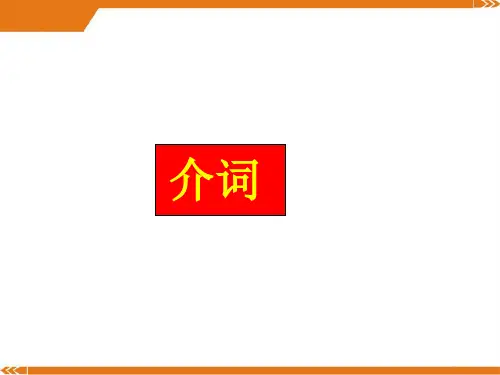
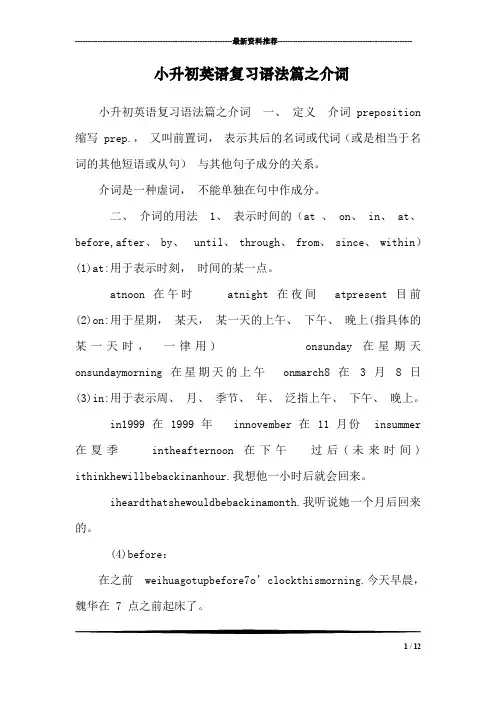
---------------------------------------------------------------最新资料推荐------------------------------------------------------小升初英语复习语法篇之介词小升初英语复习语法篇之介词一、定义介词 preposition 缩写 prep.,又叫前置词,表示其后的名词或代词(或是相当于名词的其他短语或从句)与其他句子成分的关系。
介词是一种虚词,不能单独在句中作成分。
二、介词的用法 1、表示时间的(at 、 on、 in、 at、before,after、 by、 until、 through、 from、 since、 within)(1)at:用于表示时刻,时间的某一点。
atnoon 在午时atnight 在夜间atpresent 目前(2)on:用于星期,某天,某一天的上午、下午、晚上(指具体的某一天时,一律用) onsunday 在星期天onsundaymorning 在星期天的上午onmarch8 在 3 月8 日(3)in:用于表示周、月、季节、年、泛指上午、下午、晚上。
in1999 在 1999 年 innovember 在 11 月份 insummer 在夏季intheafternoon 在下午过后(未来时间) ithinkhewillbebackinanhour.我想他一小时后就会回来。
iheardthatshewouldbebackinamonth.我听说她一个月后回来的。
(4)before:在之前weihuagotupbefore7o’clockthismorning.今天早晨,魏华在 7 点之前起床了。
1 / 12(5)after:在之后afterthat,nonoeshouldeverkillaseagull. 从那时起,任何人不得捕杀海鸥。
(6)by:在前(时间),截止(到) bythetimeiarrived,shehadalreadygone. 在我到达之前,她已经走了。

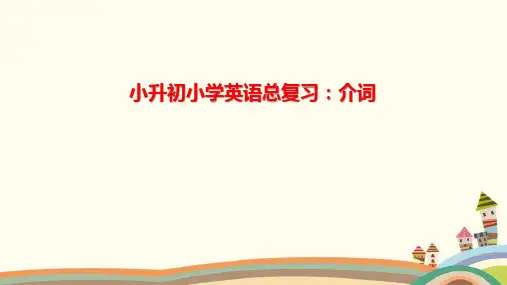
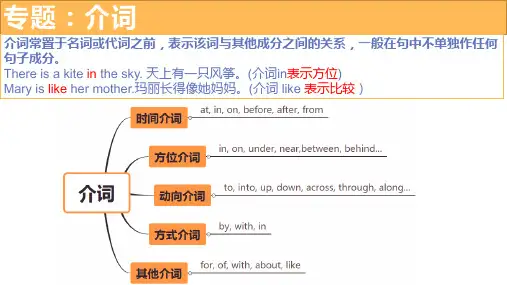

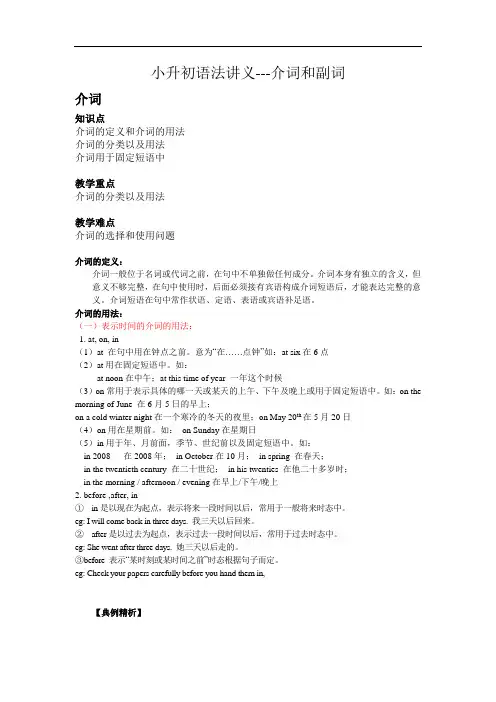
小升初语法讲义---介词和副词介词知识点介词的定义和介词的用法介词的分类以及用法介词用于固定短语中教学重点介词的分类以及用法教学难点介词的选择和使用问题介词的定义:介词一般位于名词或代词之前,在句中不单独做任何成分。
介词本身有独立的含义,但意义不够完整,在句中使用时,后面必须接有宾语构成介词短语后,才能表达完整的意义。
介词短语在句中常作状语、定语、表语或宾语补足语。
介词的用法:(一)表示时间的介词的用法:1. at, on, in(1)at 在句中用在钟点之前。
意为“在……点钟”如:at six在6点(2)at用在固定短语中。
如:at noon在中午;at this time of year 一年这个时候(3)on常用于表示具体的哪一天或某天的上午、下午及晚上或用于固定短语中。
如:on the morning of June 在6月5日的早上;on a cold winter night在一个寒冷的冬天的夜里;on May 20th在5月20日(4)on用在星期前。
如:on Sunday在星期日(5)in用于年、月前面,季节、世纪前以及固定短语中。
如:in 2008 在2008年;in October在10月;in spring 在春天;in the twentieth century 在二十世纪;in his twenties 在他二十多岁时;in the morning / afternoon / evening在早上/下午/晚上2. before ,after, in①in是以现在为起点,表示将来一段时间以后,常用于一般将来时态中。
eg: I will come back in three days. 我三天以后回来。
②after是以过去为起点,表示过去一段时间以后,常用于过去时态中。
eg: She went after three days. 她三天以后走的。
③before 表示“某时刻或某时间之前”时态根据句子而定。
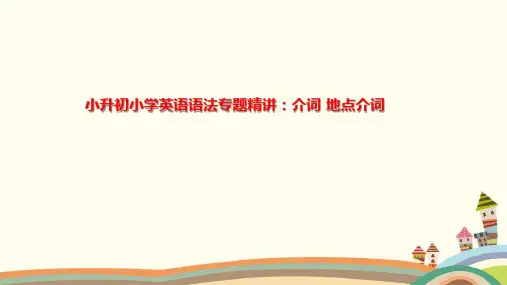
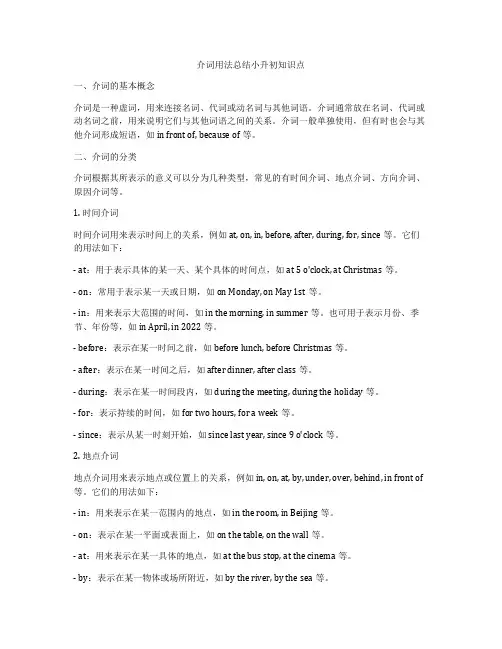
介词用法总结小升初知识点一、介词的基本概念介词是一种虚词,用来连接名词、代词或动名词与其他词语。
介词通常放在名词、代词或动名词之前,用来说明它们与其他词语之间的关系。
介词一般单独使用,但有时也会与其他介词形成短语,如in front of, because of等。
二、介词的分类介词根据其所表示的意义可以分为几种类型,常见的有时间介词、地点介词、方向介词、原因介词等。
1. 时间介词时间介词用来表示时间上的关系,例如at, on, in, before, after, during, for, since等。
它们的用法如下:- at:用于表示具体的某一天、某个具体的时间点,如at 5 o'clock, at Christmas等。
- on:常用于表示某一天或日期,如on Monday, on May 1st等。
- in:用来表示大范围的时间,如in the morning, in summer等。
也可用于表示月份、季节、年份等,如in April, in 2022等。
- before:表示在某一时间之前,如before lunch, before Christmas等。
- after:表示在某一时间之后,如after dinner, after class等。
- during:表示在某一时间段内,如during the meeting, during the holiday等。
- for:表示持续的时间,如for two hours, for a week等。
- since:表示从某一时刻开始,如since last year, since 9 o'clock等。
2. 地点介词地点介词用来表示地点或位置上的关系,例如in, on, at, by, under, over, behind, in front of 等。
它们的用法如下:- in:用来表示在某一范围内的地点,如in the room, in Beijing等。

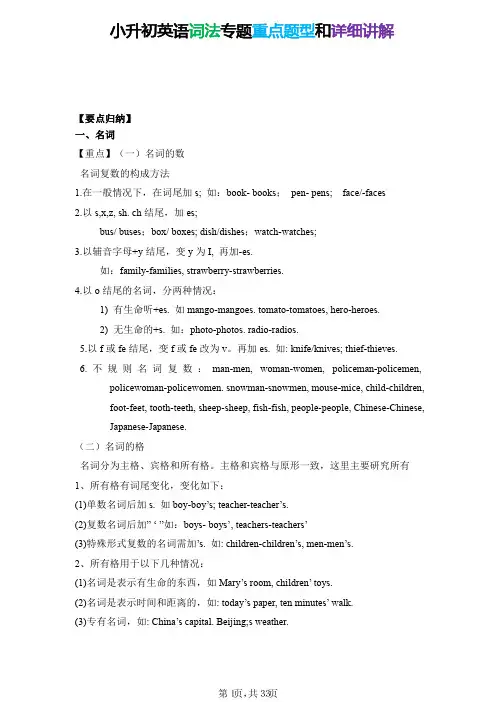
小升初英语词法专题重点题型和详细讲解一、词法(名词、冠词、代词)二、词法(形容词、副词、数词)三、词法(动词、介词、连词)【要点归纳】一、名词【重点】(一)名词的数名词复数的构成方法1.在一般情况下,在词尾加s;如:book-books;pen-pens;face/-faces2.以s,x,z,sh.ch结尾,加es;bus/buses;box/boxes;dish/dishes;watch-watches;3.以辅音字母+y结尾,变y为I,再加-es.如:family-families,strawberry-strawberries.4.以o结尾的名词,分两种情况:1)有生命听+es.如mango-mangoes.tomato-tomatoes,hero-heroes.2)无生命的+s.如:photo-photos.radio-radios.5.以f或fe结尾,变f或fe改为v。
再加es.如:knife/knives;thief-thieves.6.不规则名词复数:man-men,woman-women,policeman-policemen,policewoman-policewomen.snowman-snowmen,mouse-mice,child-children,foot-feet,tooth-teeth,sheep-sheep,fish-fish,people-people,Chinese-Chinese,Japanese-Japanese.(二)名词的格名词分为主格、宾格和所有格。
主格和宾格与原形一致,这里主要研究所有1、所有格有词尾变化,变化如下:(1)单数名词后加s.如boy-boy’s;teacher-teacher’s.(2)复数名词后加”‘”如:boys-boys’,teachers-teachers’(3)特殊形式复数的名词需加’s.如:children-children’s,men-men’s.2、所有格用于以下几种情况:(1)名词是表示有生命的东西,如Mary’s room,children’toys.(2)名词是表示时间和距离的,如:today’s paper,ten minutes’walk.(3)专有名词,如:China’s capital.Beijing;s weather.(4)介词of可以表示所有格,它一般用于无生命意义的名词,如:the title of the film.the gate of the school.【难点】1.名词性物主代词:常用的有:mine,yours,his,hers,its,ours,yours,theirs.其特点是:译成汉语都有“的”;后面不加名词;名词性物主代词=形容词性物主代词+名词。
介词(基础篇)1考点一:方位介词方位介词是表示位置和方向的介词.常用的方位介词有on,over,above,under, below,in,at,about,around,behind,between,among,beside,near等.1.on,over和above的用法on,over和above都有“在…上面”的意思,但这三个调在意义上还是有一些区别的。
(1)on表示两个物体的表面相互接触,例如:There is a plant on the desk.书桌上有一株植物。
(植物紧贴着桌面)(2)over表示“在…的正上方”,两个物体表面没有接触,侧如:A lamp hung over the table.桌子上方挂着一盏灯。
(灯和桌面没有接触)(3)above表示一个物体在另一个的上方,但不一定是在正上方,两个物体之间没有接触。
例如:Look!A lot of birds are flying above the trees.看!许多鸟正在树的上空飞。
2.under和below的用法under和below都有“在…下面”的意思,不过这两个词也是有区别的.(1)under表示“在…的正下方”。
例如:There is a cat under the table.桌子下面有一只猫。
(2)below表示"在…的下面",但不强测是否在正下方,例如:Our classroom is below theirs.我们的教室在他们(教室)的下面。
介词(基础篇)2 3.in的用法in表示"在…里面",也可以用来表示在一个很大的空间内。
例如:There are some books in the box箱子里有一些书。
4.at,about和around的用法at表示"在…旁边",about或around表示"在…周围"。
(1)at表示在某物旁边。
1.介词,是小升初复习中既基础又重要的知识点,是一个比较细又容易出错的知识点,通常在“单项选择”、“完形填空”“作文”写作题中考进行考察。
2.时间介词,地点介词,介词搭配是小升初英语介词中,考查的重点。
1. 熟记常见时间介词、地点介词的基本用法。
2. 熟记常考的介词短语搭配。
3. 将介词正确运用在作文、完形填空、选择题中。
1.时间介词in, on, at, during.2.地点介词in ,on, at.3.介词后的动词名词/代词/ving形式。
4.常见介词用法。
介词定义:英语介词(preposition 简写prep.,以下简称介词。
)介词是一种虚词,不能单独作句子成分,只能用在一个名词、代词或相当于名词的结构之前,可以与后面的词一起构成介词短语。
小学阶段常见介词:in,on,with,by,for,at,about,under,of,from, to,during,before, after,beside, behind, below, above, into, over,within,up, down。
介词后+名词/代词/Ving形式。
以下就常考介词进一步分析:1.at 用在某一段时刻。
Eg. at dawn/daybreak 在黎明at six (o’clock)在六点at night在夜晚at 4:30在4点30用at 来表示在……岁时at sixteen/at the age of sixteen :16岁的时候I go to school _______seven every day.A. atB. inC. onD. for答案:A2.on主要用在星期几、具体某一天或某一天的早、中、晚或节日前。
Eg. on Mid-Autumn Day 在中秋节on June 1st 在6 月1 日on Christmas Day 在圣诞节那一天,也可用at Christmason New Year's Day在新年那天I usually stay ______home______Saturday.A .at, on B. at, inC. in, atD. in, on答案:A3.in表示一段时间,用于年、月、四季或泛指的一天的上午、下午、晚上等前。
清大教育学科教师辅导讲义学员编号:年级:课时数:学员姓名:辅导科目:学科教师:授课类型T(介词的用法) C (介词的固定搭配)T (学法与能力主题)授课日期及时段教学内容一、同步知识梳理知识点1:介词又叫前置词,是一种用来表示词与词、词与句之间关系的词,它一般放在名词、代词(宾格)或动词(动词ing形式)前面。
知识点2:in①在... 里面。
如:in the classroom②in +颜色,穿着...... 颜色的衣服。
如:Who s the man in white?③in +语言,用某种语言说。
如:What' s thisin English?④在上午、下午、晚上。
如:in the morni ng ,in the after noon ,in the eve ning⑤在年、月、季节前。
如:in 2008,in August,in summer⑥在国家、城市和较大的地方前。
如:in China,in Wuxi,in the playground⑦固定搭配。
女如:in the middle of (在... 中间),do well in (擅长),in the day (在白天),take part in (参加),stay in bed (躺在床上),in the street (在街上)知识点3:on①在... 上面。
如: on the desk②用在某一天(上、下午)前。
如:on the 5th of May,on Sun day,on Mo nday morni ng③以Day 结尾的节日前。
如:on Children ' s Dayon New Year' s Day④固定搭配。
如:on foot (步行),on duty (值日),put on (穿上),get on (上车)turn on (打开),on the right /left (在右边 / 左边),on the wall (在墙上), on Zho ngshan Road (在中山路上) 注 意:树上长的水果 用on the tree ;不是树上长的外来物 用in the tree 。
介词
1.before 和 after 表示时间的先后顺序
before表示:在......之前
after表示:在......之后
例如:before eight o’clock 八点之前 after lunch 午饭后
You should wash your hands before supper.
The boys often play football after school.
2.over 和 above 表示位置
over 表示:“在......正上方”,强调在某人或某物的正上方,而且两物体表面表面没有接触。
above 表示:“在......上方”,强调位置在某物体的上方,并不一定是正上方,而且两物体表面也没有接触。
例如: I saw a wood bridge over the river.
Look! Some bieds are flying above the trees.
3.under 和 below表示位置
under表示:“在......正下方”,强调在某物的下方,完全覆盖两物体的表面可以接触也可以不接触。
below表示:“在......下方”,强调位置低于某参照物,但并不一定是正下方。
例如:There is a cat under the table .
Our classroom is below theirs .
4.between 和 among
between表示:(位置、时间、数量等)在......之间(两者之间)
among表示:在......中间(三者或三者以上之间)
例如:I often fly between Beijing and Shanghai.
Come here between eight and nine o’clock.
Tom is among the crowd.
5.behind 和 in front of
behind 表示:在......后面
in front of表示:在......前面
例如:The cat is behind the door.
There is a big tree in front of the park.
Zhang San sits in front of me and Li Si sits behind me .
6.in front of 和 in the front of的比较
in front of表示一定范围外的前面例如:in front of the house 房子的前面(在房子外)
in the front of 表示一定范围内的前面例如:in the front of the classroom 教室的前面(在教室内)
into 和 out of 表示动态的介词,都表示动作方向
into 表示:从外向里,进来
out of:表示由里向外,出去
例如:I put the books into my bag.
He takes the gift out of the box.
7.into 和 in 的比较
into表示动态的进入
in 表示静态的在里面
8.up 和 down表示动态的介词,都表示动作方向
up表示:由下向上,向......顶上,常与climb等动词连用
down表示:由上向下下,沿着......往下
例如:The monkey climbed up the tree quickly.
Sit down ,please.
9.from 和 to
from 表示起点,“从.....”“来自.....”
例如:He is from China.
to表示终点,“到......;向......;往.....”,意思和from刚好相反。
它前面最常用的动词就是go.
例如:Let’s go to school.
from...to... 表示时间时意思是“从......到......”
例如:We have classes from Monday to Friday.
She did her homework from morning to evening.
另外: from...to... 也可以用来表示地点,意思仍然是“从......到......”
例如:The train is from Beijing toTianjin .
10.across 、through 和 along
across 、through 表示“穿过......” ,但是用法有区别
across 表示人或物从另一个物体表面穿过、跨过,强调从一端到另一端,含有“横穿”的意思,常与street 、 bridge、raod等名词连用。
例如:
There is a bridge across the river .
Go across the street ,and you’ll find a school.
Through 表示从物体内部空间(如森林、隧道、云层等)穿过,“从......里面穿过”。
例如:
We walked through the forest。
Along 表示:沿着,顺着,常与road 、street 、river等名词连用。
如:Go along the road ,and then turn left.
介词练习
一、选择填空。
1、Class finishes_______ half past nine.
A .at B. in C.on D.to
2、Class begins at eight o’clock.You’d better get to school _______ 8:00.
A.at
B. in
C.on
D.before
3、You should wash you hands _______eating,and you shouldn’t exercise ___eating .
A.at ;at
B.in; to
C. after;before
D.before;after
4、We have classes _______ 8 am _______ 3 pm every day.
A.at,at
B.at,to
C.until,to
D.from,to
5、Seven is the number _______ six and eight.
A. in
B.between
C.among
D.at
6、Walk down the street and walk _______the bridge,you will see the shop.
A.cross
B.at C .through D.across
二、把正确答案圈起来。
1、The train leaves (at,in)2:30pm.
2、I received a beautiful card from Tom (in,on )my birthday.
3、(From ,At)7 to 9 (in,before)spring,he often runs around the playground.
4、My brother washed the dishes (at,after)supper.
5、Do you preview (预习)lessons (after,before)class?
6、When did you arrive (at,on)the bus stop.
7、The dog is jumping (on ,over)the fence(篱笆)。
8、The first astronaut landed on the moon (in,on)1968.
9、The train is driving(through,across)the tunnel.
三、根据中文意思,填写恰当的介词。
1、我们房后有棵大树。
There is a big tree _______ our house.
2、在这幅画里你能看到什么?
What can you see_______this picture.
3、看!汤姆正站在车站旁。
Look!Tom is standing _______ the bus stop.
4、啊,我的袜子在床底下。
Aha,my socks are _______ the bed.
四、根据中文意思填写介词,把短语补充完整。
1 跑出房间 run _______ the room
2 爬上山 climb _______ the hill
3 穿过隧道 drive_______the tunnel
4 飞往巴黎的飞机 a plane flying _______Paris
5 走出商店 walk _______ the store
6 沿着这条大街走 go _______this street
7 走进电梯 walk _______ the elevator。